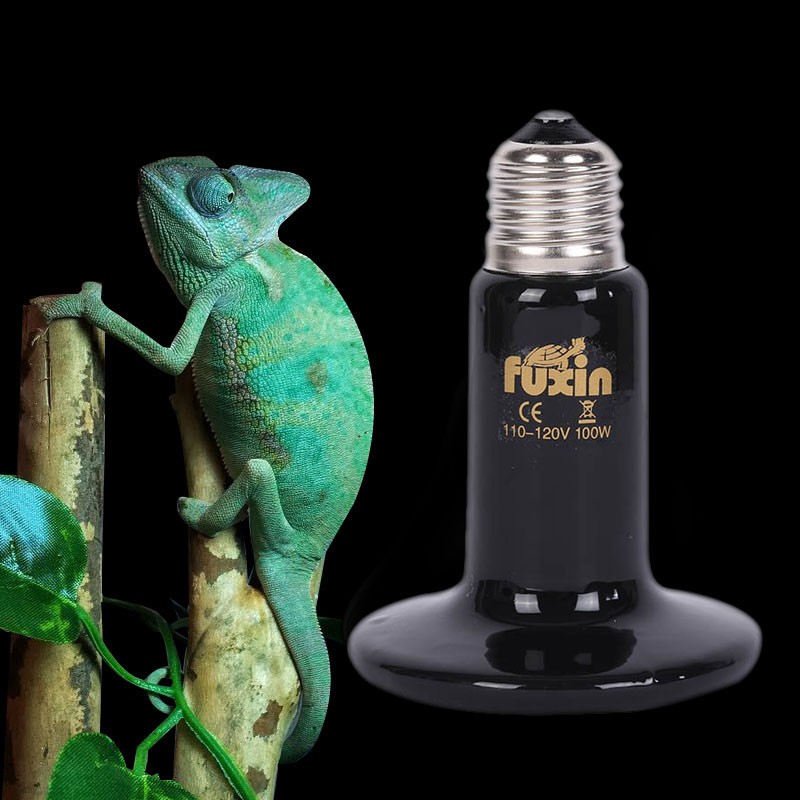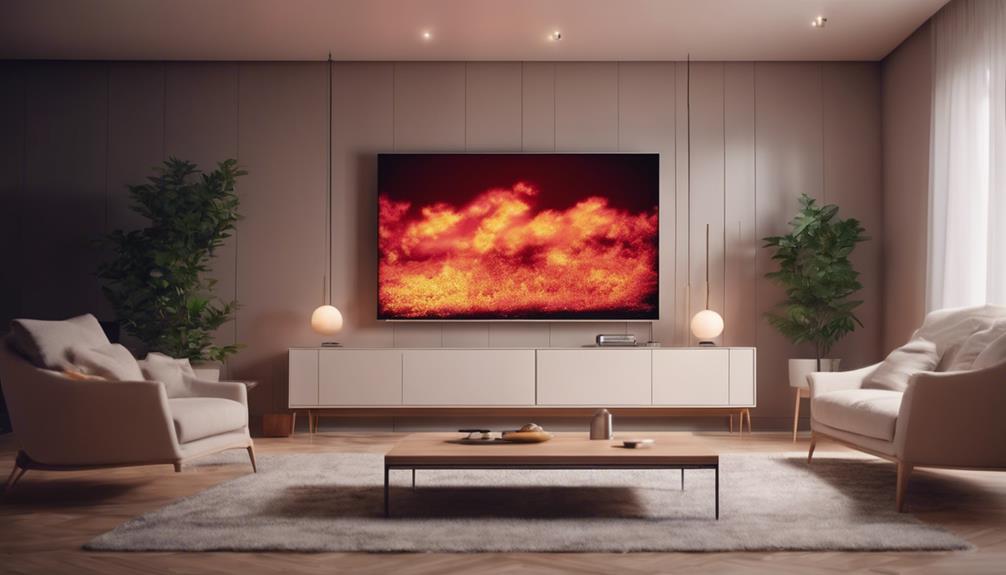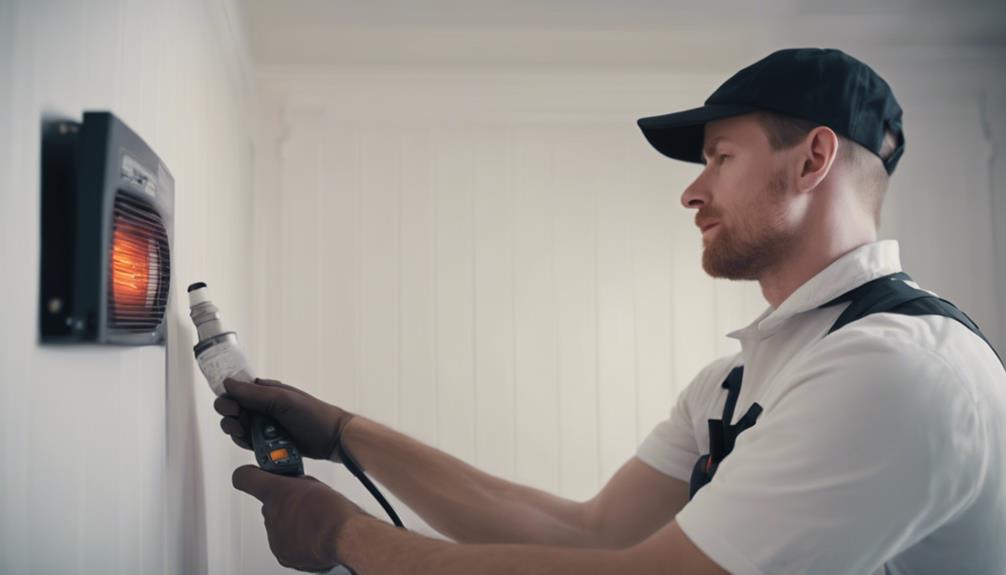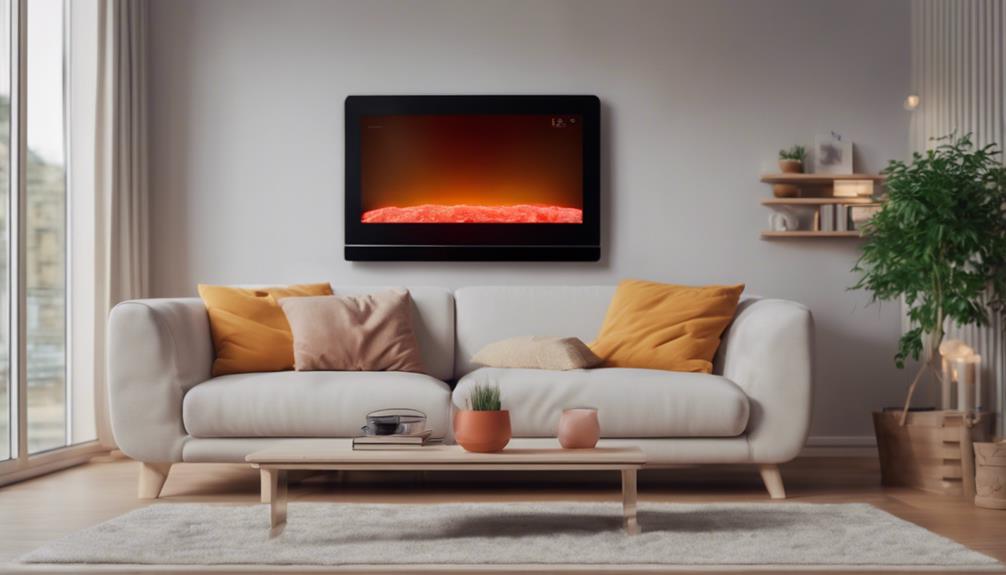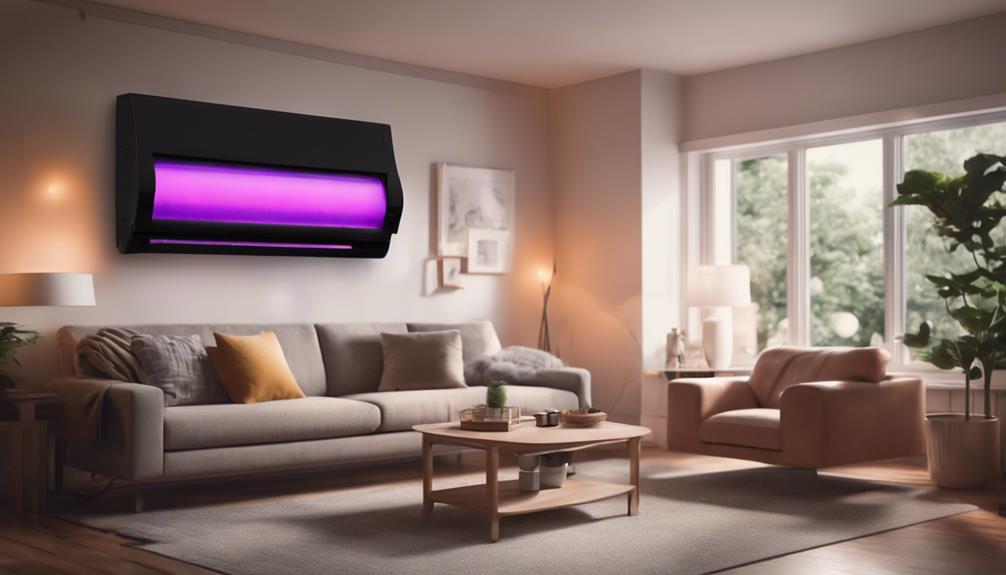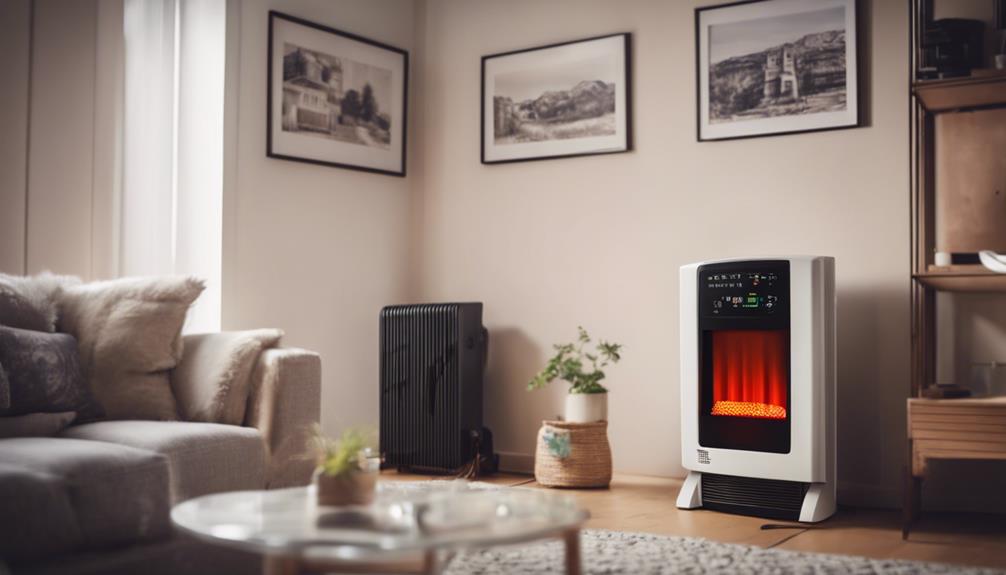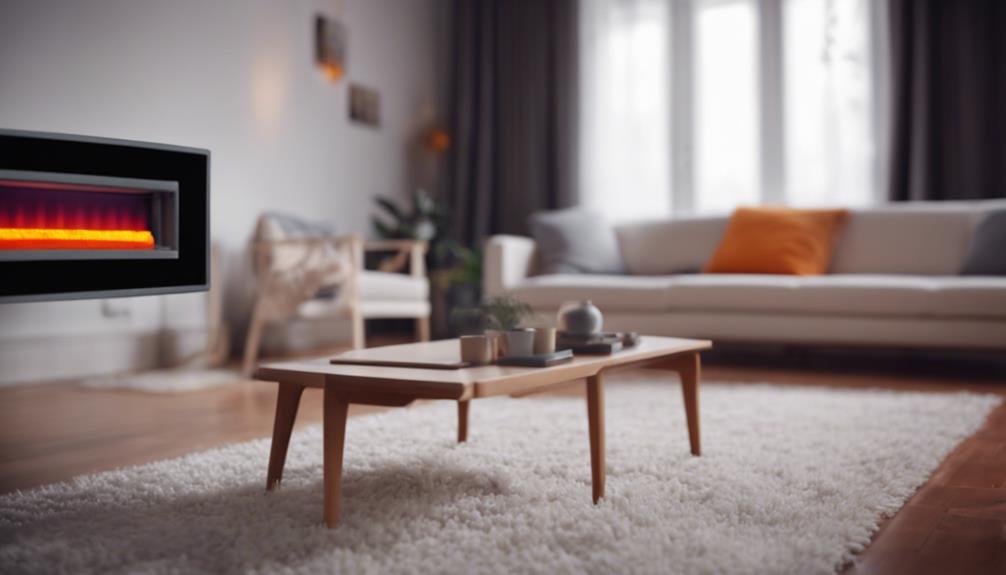
For you, seeking cost savings and efficient heating, infrared heaters excel. They use up to 30% less energy than traditional systems, directly heating objects to minimize waste on unoccupied areas. With instant heat delivery and focused warmth, you reduce energy usage greatly. Targeted heating in occupied spaces ensures quick comfort without unnecessary expense. The long-term benefits include lower operational costs, minimal maintenance requirements, and overall energy efficiency. Opting for eco-friendly infrared heaters not only saves you money but also reduces greenhouse gas emissions. Explore the full spectrum of benefits these heaters offer for your cost-effective solution.
Energy Efficient Heating Technology
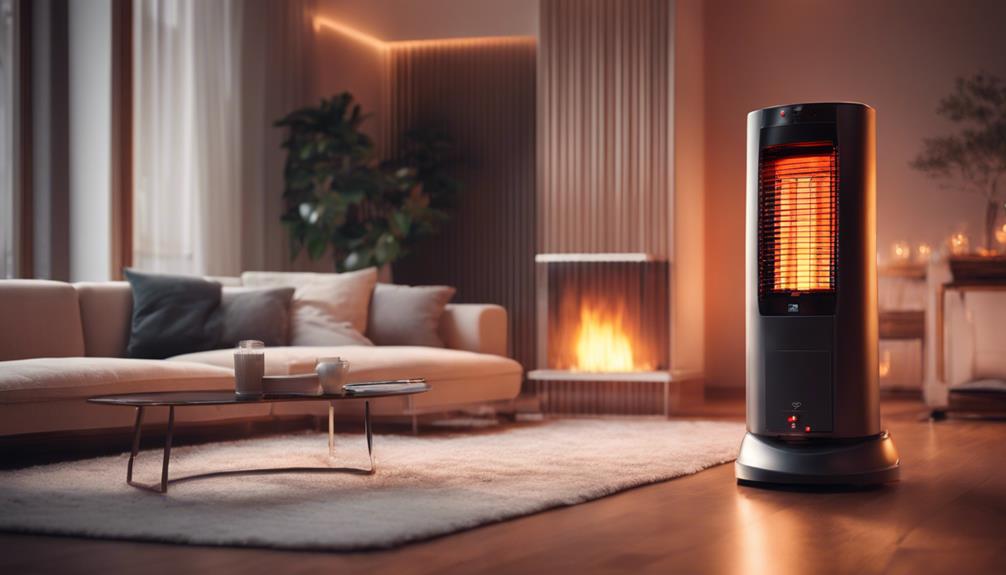
When considering energy-efficient heating technology, infrared heaters stand out for their ability to provide targeted warmth while minimizing energy waste. In comparison to traditional heating alternatives, infrared heaters offer significant benefits regarding energy consumption.
Infrared heaters operate by emitting infrared radiation that directly heats objects and individuals in its path, rather than heating the air. This focused approach results in less energy being wasted on heating empty spaces or areas that don't require warmth. As a result, infrared heaters can be up to 30% more energy-efficient than other heating alternatives.
Moreover, the instant heat provided by infrared heaters further contributes to their energy efficiency. Traditional heating systems often require extended periods to warm up a room, leading to higher energy consumption. In contrast, infrared heaters deliver immediate warmth, allowing for quick comfort without unnecessary energy expenditure.
Instant Heat With Infrared Heaters
Infrared heaters deliver immediate warmth, guaranteeing rapid comfort without unnecessary energy expenditure. These heaters work by emitting infrared radiation that heats objects directly, rather than heating the air. This means you can feel the warmth almost instantly upon turning the heater on, unlike traditional heaters that take time to warm up the entire room.
When using infrared heaters for instant heat, it's crucial to take into account safety features such as tip-over protection and overheating sensors. These features help prevent accidents and guarantee safe operation, giving you peace of mind while enjoying the warmth.
For peak performance, think about installing your infrared heater in a central location within the room. This placement allows for efficient heat distribution and guarantees that you feel the warmth quickly and evenly. Additionally, make sure there are no obstructions blocking the infrared rays to maximize the heater's effectiveness.
Targeted Heating for Cost Efficiency

To achieve cost efficiency, consider utilizing targeted heating strategies with infrared heaters.
By implementing zone heating, you can focus on heating specific areas where people are present, rather than wasting energy heating the entire space. This approach allows for more efficient use of energy, as you can avoid heating unoccupied rooms or spaces.
Infrared heaters offer precise comfort control by directly heating objects and individuals in their path, providing instant warmth without the need to heat the air first.
Zone heating with infrared heaters can result in significant cost savings by reducing the overall energy consumption required to maintain a comfortable environment.
By targeting only the areas where heat is needed, you can optimize energy usage and avoid unnecessary expenses.
Additionally, the ability to control the heating output of each individual heater allows for personalized comfort settings, further enhancing the cost efficiency of using infrared heaters for targeted heating purposes.
Reduced Energy Wastage
Minimize energy wastage by strategically deploying infrared heaters to target specific areas for heating, optimizing efficiency and reducing unnecessary consumption.
Infrared heaters excel in energy conservation by emitting heat that directly warms objects and individuals, unlike traditional heaters that warm the air first. This targeted approach guarantees minimal heat loss, as heat isn't wasted on heating unoccupied spaces or circulating air. By focusing on heating specific zones or people, infrared heaters maximize heat retention, keeping the warmth where it's needed most.
Compared to conventional heating systems, infrared heaters offer superior energy efficiency due to their ability to deliver instant heat without the need for preheating or constant cycling.
This efficiency translates into significant energy savings over time, reducing operational costs and environmental impact. Additionally, the precise control options of infrared heaters allow you to adjust heat output according to specific requirements, further enhancing energy conservation.
Lower Operational Costs
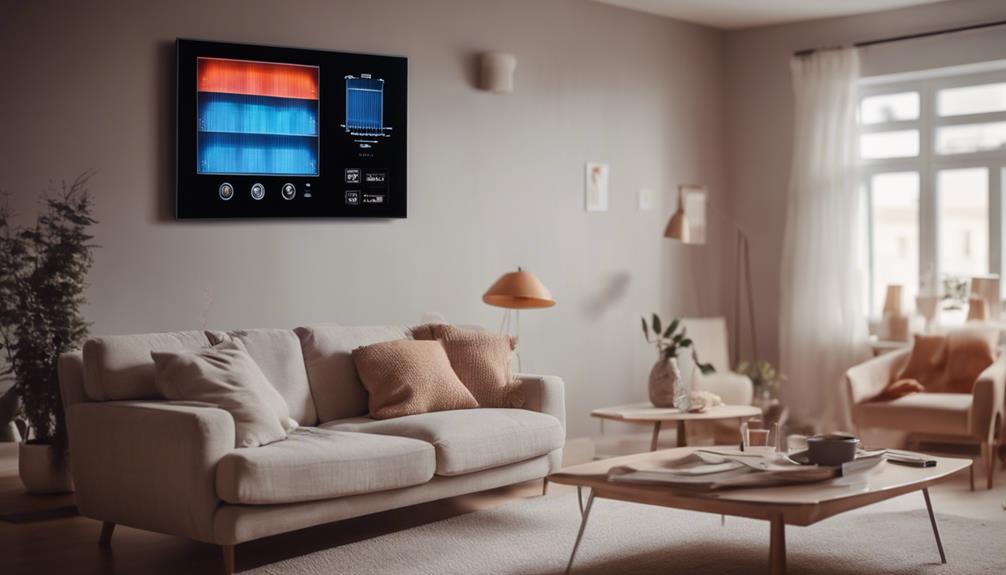
Strategically managing heating zones using infrared heaters can greatly decrease operational costs through targeted energy usage. By installing infrared heaters, you can control the heating of specific areas without needing to heat the entire space, leading to considerable savings on energy bills.
The installation costs for infrared heaters are generally lower compared to traditional heating systems, allowing for immediate cost benefits. Additionally, these heaters require minimal maintenance, further reducing operational expenses over time.
When considering operational costs, the efficiency of infrared heaters plays an essential role. Their ability to heat objects directly, instead of wasting energy on heating the air, guarantees that energy is used more efficiently.
This focused heating approach not only saves energy but also translates into cost savings for your business. Furthermore, the reduced maintenance expenses associated with infrared heaters contribute to their overall cost-effectiveness.
Long-Term Savings Benefits
Harnessing the long-term savings benefits of infrared heaters involves maximizing energy efficiency and minimizing maintenance costs over time.
When conducting an investment analysis for heating systems, it's essential to take into account not only the initial purchase cost but also the operational expenses in the long run.
Infrared heaters are known for their energy efficiency, converting nearly all the energy they consume into radiant heat, which helps reduce overall energy usage and costs. This efficiency translates into significant savings on your energy bills, making them a smart choice for budget planning.
Moreover, infrared heaters require minimal maintenance compared to traditional heating systems, resulting in lower long-term upkeep expenses.
By integrating these factors into your budget planning, you can accurately estimate the total cost of ownership over the lifespan of the heaters.
This approach allows for informed decision-making that takes into consideration both upfront costs and long-term savings potential, making infrared heaters a cost-effective and efficient heating solution for residential and commercial spaces.
Eco-Friendly Heating Solution

Infrared heaters offer an environmentally sustainable heating solution due to their efficient energy conversion and reduced carbon footprint.
These heaters use infrared radiation to directly heat objects and people in a room, instead of wasting energy on heating the air. This focused heating method results in less energy consumption compared to traditional heating systems, ultimately reducing greenhouse gas emissions and promoting eco-friendliness.
Moreover, many infrared heaters are constructed using sustainable materials, such as recycled plastics and metals, further contributing to their eco-friendly profile. By choosing an infrared heater made from sustainable materials, you not only reduce your carbon footprint but also support environmentally conscious manufacturing practices.
Additionally, infrared heating has been associated with various health benefits. Unlike conventional heaters that circulate air and dust particles, infrared heaters don't dry out the air, helping to maintain ideal humidity levels in a room. This can benefit individuals with allergies or respiratory conditions, providing a healthier indoor environment.
Conclusion
To wrap up, infrared heaters are ideal for cost savings due to their energy efficiency and targeted heating capabilities.
By providing instant heat and reducing energy wastage, these heaters offer lower operational costs and long-term savings benefits.
Additionally, their eco-friendly nature makes them a sustainable heating solution for both residential and commercial spaces.
Consider investing in infrared heaters to maximize cost savings and efficiency in your heating system.
